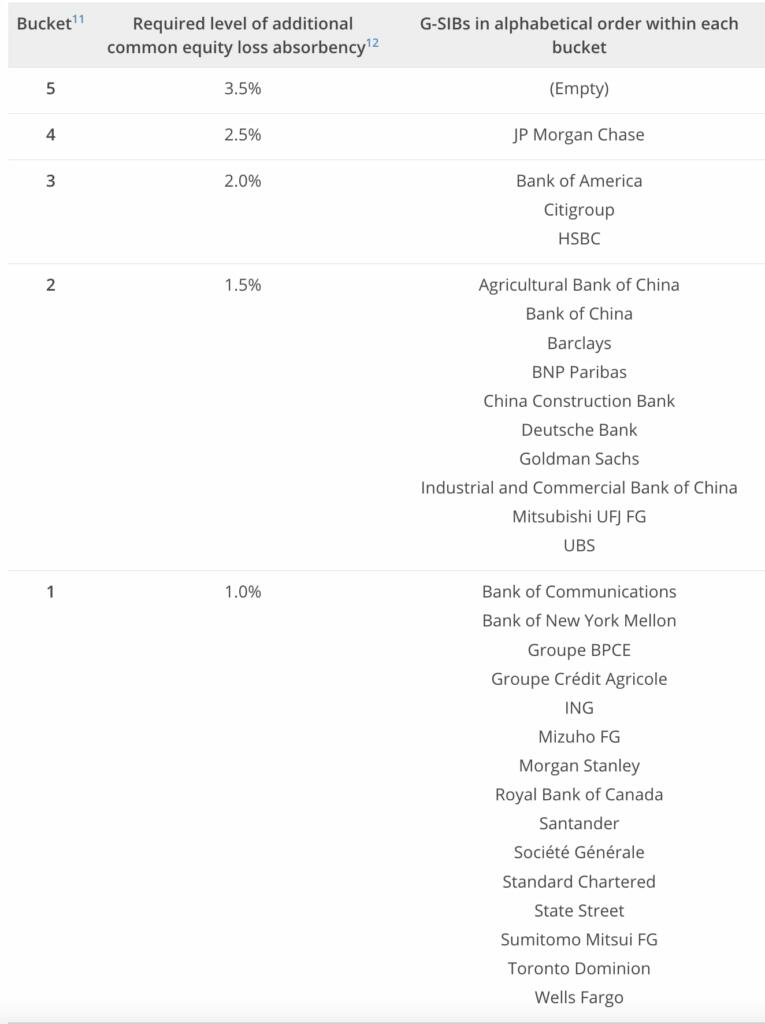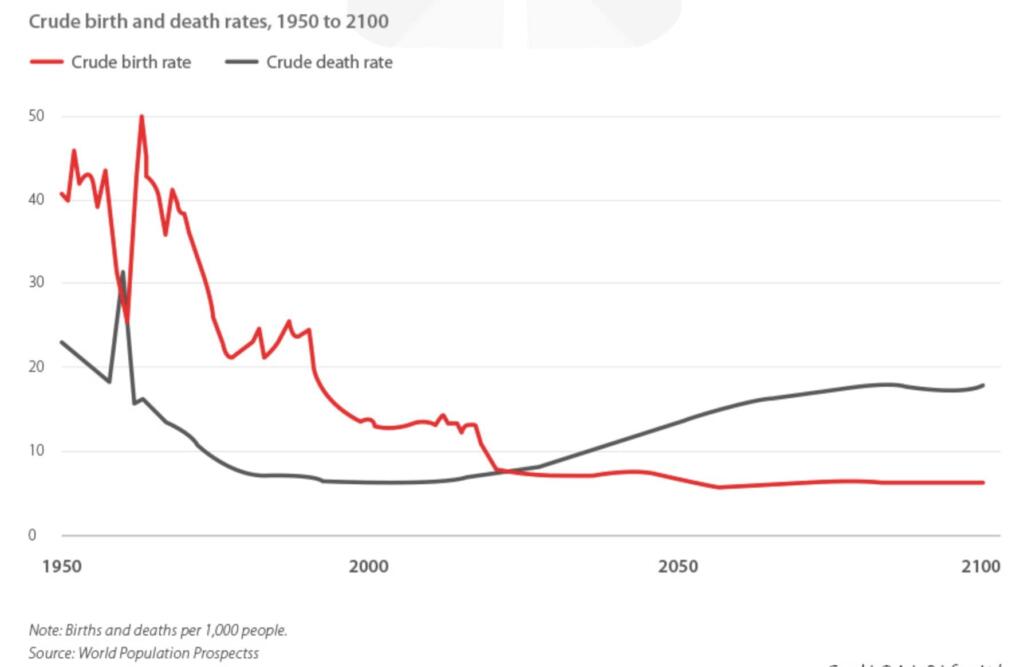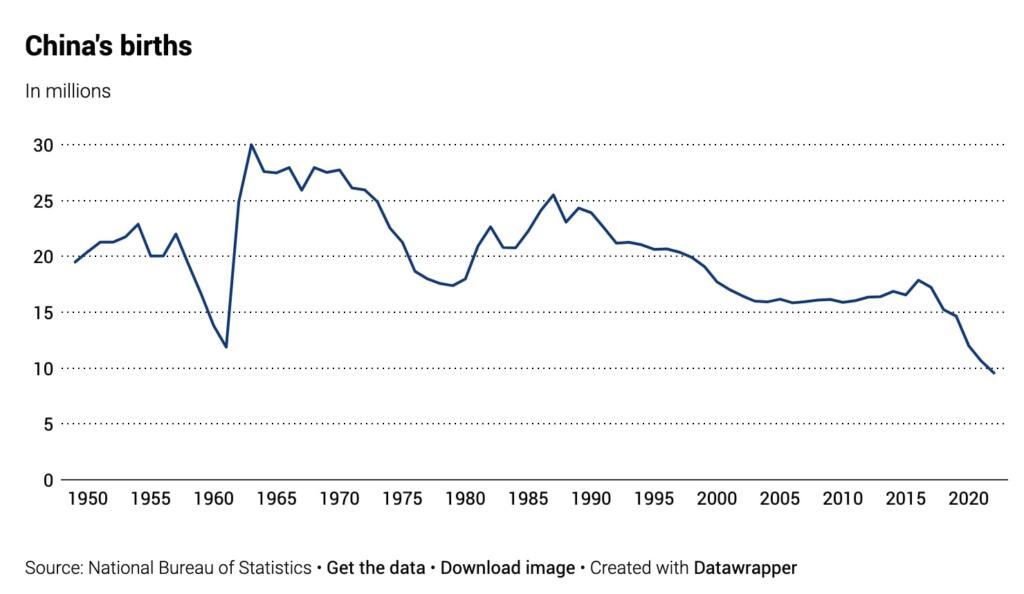The population collapse is global. Over 80% of the world population is in countries with declining populations or where births have dropped below replacement. Even India and Bangladesh have dropped below replacement. Once a country drops below replacement then it is about two to four decades from population decline.
We have a connected world economy. The collapse of a globally important bank can trigger a global financial crisis. 9 of the World’s top 15 global systemically important banks are Chinese, Japanese or European. The population collapse is not their problem alone. If it triggers major banking implosions, global recession or permanent global depression, then people will say hey that mattered. The mortgage and banking crisis of 2008 would be small and minor relative to losing one of the top 15 banks. Losing 9 of the banks would be a financial catastrophe.

Japan’s population peaked around 2010 at 128.1 million people. The population has declined to 123 million. However, the decline is accelerating, and by 2050, Japan’s population is expected to fall to 106 million, and by 2100, to 75 million.
China’s overall population could start dropping by 15 million people each year as early as 2033.


According to projections, the number of people aged 60 and above will exceed 300 million in 2024, 500 million in 2048, and reach a peak of 524 million in 2052, and the number of people aged 65 and above is expected to exceed 300 million in 2033, exceed 400 million in 2050, and reach a peak of 436 million in 2057. Census 2020, the number of urban elderly exceeded that of rural areas. The number of rural elderly is still growing, and the proportion of the elderly population is 8% points higher than that of urban areas.
It will take about 15 years for China median age to get up to Japan’s 48.
China’s economy is under pressure as its population declines and gets old. The number of seniors who age out of the workforce is already huge. The working age population could drop by 250 million by 2050.
Slightly over 9 million babies were born in 2023 – the lowest level since records began in 1949 – while about 11 million people died, pushing the death rate to a five-decade high.
The falling number of new babies resulted in the lowest birth rate in over seven decades, with 6.39 births for every 1,000 people compared with 6.77 in 2022.
China’s overall population is set to see steeper decline in the coming years, said professor Peng Xizhe from the Centre for Population and Development Policy Studies at Fudan University.
China is crazy to believe population of over 1 billion by 2100. This would only be the case if birthrates increased a lot and extreme antiaging science was develpoed.
IF the number of babies per year is 9 million per year for 80 years this would be 720 million people. If the number of babies per year is 8 million per year for 80 years this would be 640 million. However, holding the number of babies stable would be difficult when the number of fertile women collapses.
There are currently 160 million potentially fertile women in the age range of 16-34. This will drop to 130 million potentially fertile women in 20 years. These are the girls 0-15 and the added 4.5 million female babies if there were 9 million babies per year. In 15 years after that, there would only be 70-90 million fertile women. The babies per year could drop to 3-4 million per year if those fertile women were having babies as the same rate as the women today. The number of female babies would drop to less than 2 million per year before 2058. If life expectancy was still 85 years then the population would be less than 400 million in 2100. If life expectancy was 20 years longer than there could be 200 million more people.
The 9 million per year is 40% of the number of babies born around 1990. The Chinese people born 30-34 years ago average about 22-23 million per year.

Nextbigfuture believes the global population issues are urgent to sustain stable levels of fertile women. The urgent plan is to rapidly increase incentives every month until there are replacement level babies in a month. In Japan, this is about 120,000 per month and in China it is 1.5 million per month instead of 700,000 per month. The incentives need to stay at that level to sustain the replacement level of babies every month. The incentives can be reduced or modified after the data indicates adjustments can be made to be more efficient while sustaining the mathematically correct level.
Robin Hanson has come up with a plan to use the massive national debt of most countries to fund the large enough payments to make $300,000 to $700,000 payments to encourage couples to have enough babies to stop population decline.

Brian Wang is a Futurist Thought Leader and a popular Science blogger with 1 million readers per month. His blog Nextbigfuture.com is ranked #1 Science News Blog. It covers many disruptive technology and trends including Space, Robotics, Artificial Intelligence, Medicine, Anti-aging Biotechnology, and Nanotechnology.
Known for identifying cutting edge technologies, he is currently a Co-Founder of a startup and fundraiser for high potential early-stage companies. He is the Head of Research for Allocations for deep technology investments and an Angel Investor at Space Angels.
A frequent speaker at corporations, he has been a TEDx speaker, a Singularity University speaker and guest at numerous interviews for radio and podcasts. He is open to public speaking and advising engagements.


In addition to all the reasons listed above why population collapse will NOT happen, this is much ado about not much.
Here’s a chart of GDP growth in 5 low to negative population growth countries. When adjusted for demographics, they are all growing GDP per capita quite nicely, including Japan, Germany, U.S. U.K. and France. Each of these has had temporary drops, but that has more to do with supply crunches and bad policies than anything demographic. Over the last 15 years, they’ve all grown since the GFC.
https://www.commodityresearchgroup.com/japans-gdp-adjusted-for-population-wsj/
And now we have AI and robots! This will accelerate change, easily making up for the loss of human population. And a decrease in population will only make each individual worker more valuable, which is good for wages, offsetting job losses due to AI and robots.
Paying people to have children is a bad idea. The worst kinds of people are already having too many children, lowering the aggregate IQ, and leading to social problems, even an Idiocracy like in the movie by the same name. And well-off potential parents aren’t so easily bribed.
Artificial wombs, care in old age so that children are not a lifelong drain and can’t care for their aged parents, longevity breakthroughs, artificial wombs etc. are better alternatives.
Thank you, thank you, thank you. A slow draw down in global population, minimizing disruption, would be a blessing for humanity long term.
Birth rate in China
2023 6.39
2022 6.77
2021 7.52
2020 8.52
2019 10.41
We can see the speed of dropping is decelerating, from 18% in 2020 to 5.5% in 2023. I believe China can stop the dropping in 2025 and birth rate will bounce back after that.
What is somewhat concerning is that the population decline doubled compared to 2022.
I assume/hope that this is just a statistical artifact, because if that doubling is a trend, then China would lose 128 million people in 2030.
It is time to ask Elon Musk to start a company making artificial wombs. Less and less women want to have children and the trend is speeding. In the future, artificial wombs will allow men to carry on the tradition of childbearing and child rearing.
A simple solution is to arrange so most new babies born are female. This should be very simple and demographically predictable compared to other solutions. Then, the replacement rate is 1.something.
In China, they will need to have incentives for families to have girls. So far, it has been the other way around.
Yes, and this would lead to a lot less instability and terrorism too, spurred by mateless young males.
Good observation. Look at areas of the world with political or economic strife. The commonality? Aged 16-40 men. Single. No jobs. Nothing to look forward to. Bad recipe.
If you are looking for financial fallout, it should happen in real estate.
Buying real estate is basically a bet that there will be more and richer households in your area in the future.
Rural Japanese and Italian real estate is basically free because of local declines in population.
If sentiment shifts to a belief that real estate is generally a bad investment because of declining populations, forward looking markets could turn decades of future price declines into near term losses and cause financial stress.
Demographics/geography are cool tools and help understand a lot of history. Still, to a man with a hammer, the whole world looks like a nail.
India needs to lose people. I’ve been there. It’s not good. Other countries, yes, they do, too, and we just need to deal with it. Hopefully AGI and anti-aging will both pick up the slack but we shall see.
China is . . . unique.
Cutting themselves off from the world economy (almost entirely due to bad leadership and bad behavior) will have little effect on the world economy, once the thrash is over and people figure it out. As a member of the world economy, they pretty much only took, without giving back.
Yes, production will have to be built in other areas of the world to make up for ‘losing’ theirs but this is already underway and it will simply spur investment (which was actually going to be a problem with too many dollars chasing too few opportunities by the end of this decade) and provide opportunities for more modern (meaning cleaner and more efficient) facilities to be created. Also, their cost of labor was no longer a competitive advantage.
The surplus income generated during their heyday should have been used to evolve their economy, not shoveled into corruption and unusable infrastructure.
The cost (to the rest of the world) is a certain amount of anguish at seeing a huge yet rapidly aging and shrinking population left to eke out an existence in a polluted rust belt, a lot of Chinese refugees, and a self-inflicted humanitarian crisis too big to be adequately addressed, even if their leadership would permit it.
“India needs to lose people” is very Malthusian. It’s always somebody else that needs to be lost, never us, of course. Which is the only reason why somebody can be Malthusian, really.
Naw. It’s not Malthusian. Malthusian is believing that people reproduce at a faster rate than their means of sustenance. India’s problem is less about food than several other things. One being that pollution is out of control (and then look at all the people bathing in terribly polluted rivers and washing their clothes and dishes and using them for waste disposal and whatever else until you can’t hardly see the surface of the water for all the plastic floating on it as it hits the sea). Also they have lost a lot for regard for the value of human life (too much of it around can do that, I suppose–take a look at a train with half the passengers clinging to the outside). Along with huge income inequality, exacerbated by a caste system.
So? Make them all wealthy overnight? Huge emigration? Both of those solutions just tend to put problems on someone else’s plate.
Interesting to think about what could counter this trend:
– a large and sustained increase in fertility (very unlikely )
– a breakthrough in longevity – not just at old age but to keep people healthy and able to reproduce way beyond 35.
(Very unlikely)
– a breakthrough in longevity that keeps people healthy and living for extra decades ( but no extension to reproductive years)
(Unlikely but possible )
– robotics , ai and automation replacing people in many jobs – (likely but maybe not fast enough to offset the demographics )
I agree with the three offsets. I disagree about probability. I think the third is near certainty and it drives the longevity + fertility biotech to a similar probability. Plus of course artificial wombs and the other very precise and complete CRISPR based genome engineering biotech etc that would make these issues just a matter of culture, economics etc than real physical limits.
We are in the Singularity. Technological acceleration is already obviously above the baseline of the last few decades. It strikes me as very improbable if the global economy isn’t destroyed by catastrophe that 100 year olds couldn’t decide to have children a few decades from now or that human labor will be necessary for much of anything.
First, we need to know ALL the reasons for the drop in fertility. I think most of it’s social, policy related, but it’s quite possible some of it is actually biological, due to things like hormone mimetics building up in the environment. There’s some reason to believe that, there are some systematic medical things going on like reduced sperm counts. If it’s something building up in the environment, it’s only going to keep getting worse until we do something.
Second, we need to do something about policies that discourage childbirth, sometimes subtly, sometimes grossly. That’s going to be really hard, because with so few people having children, such policies will be unpopular.
I think we’ve gone through a social transition that has largely eliminated the automatic presumption that people will marry and have children, so removing the causes for that transition won’t reverse it, it’s self-perpetuating at this point.
So, third: Life extension so that people can feasibly have children at an older age, when they finally feel secure enough, and decide, yeah, they DO want kids. This is more complicated for women, because they actually run out of eggs after a while.
So, forth: Fertility treatments, gamete banks, and artificial wombs, so that everybody who’s willing to have kids is actually capable of having them. regardless of medical obstacles.
Child care is a problem is a society that expects two earner families. So, fifth: Android nannies.
Single people can still want children, so combine android nannies with gamete banks and artificial wombs. Fifth: Android spouses.
Production of children may still fall short, so combine TWO android nannies with gamete banks and artificial wombs, and you get… Sixth: Artificial families.
Of course, once you bring in the android nannies, the potential for government or tech bro social engineering is pretty dire. I don’t think we’re coming out the other side of this looking anything like 1950’s America.
It could be a Ratopia kind of mechanism.
Absolutely. This is a slowing moving catastrophe. But societies in general don’t act for something that takes decades to play out and is hardly noticeable in the moment. In 20 years when the collapse really begins it may to too late to arrest.
Western world leaders want the collapse. Good for Gaia.
Define “leaders.”
The plutocrats meeting in Davos this week?
Then review their motivation and positions on the Jeffrey Epstein airline archive.